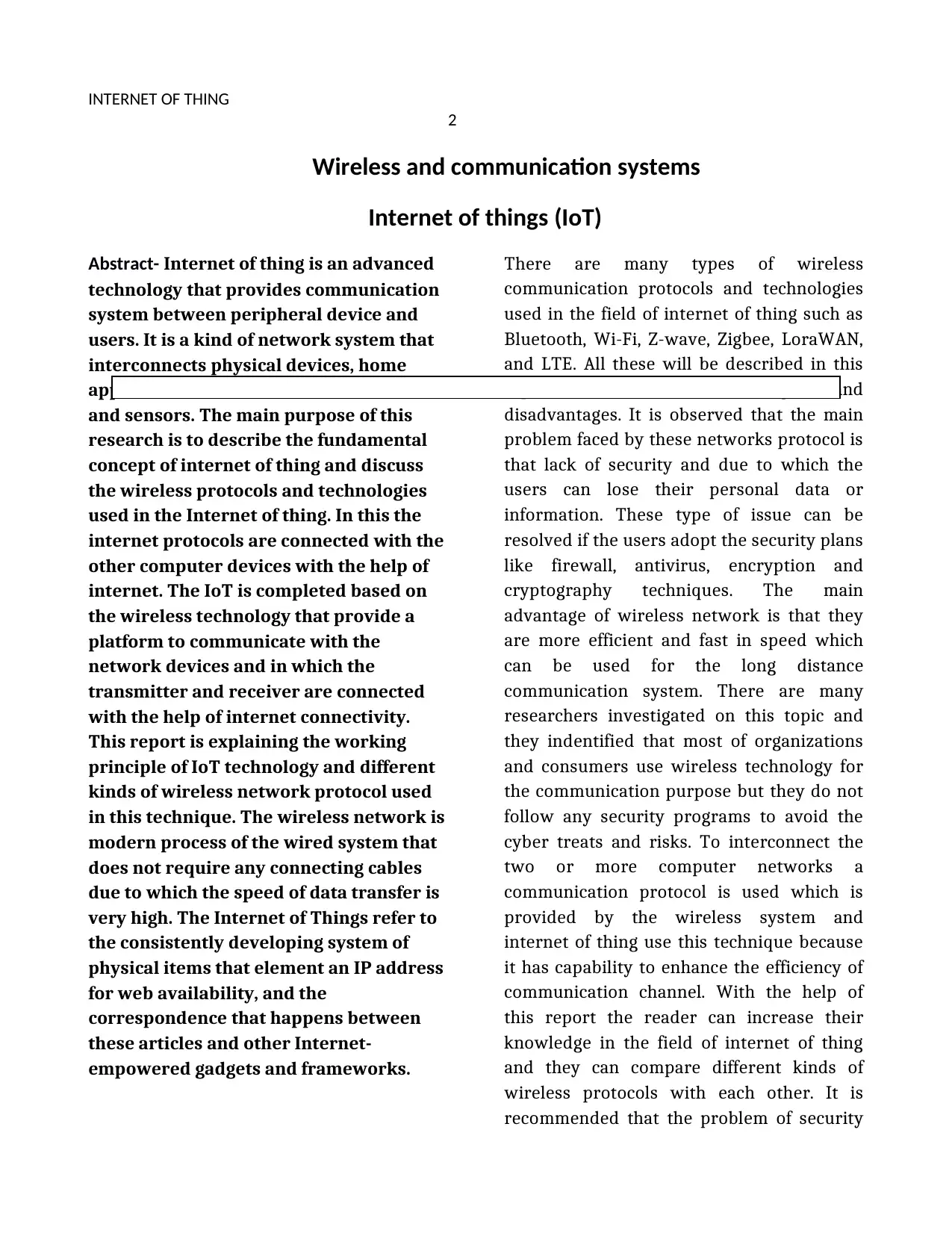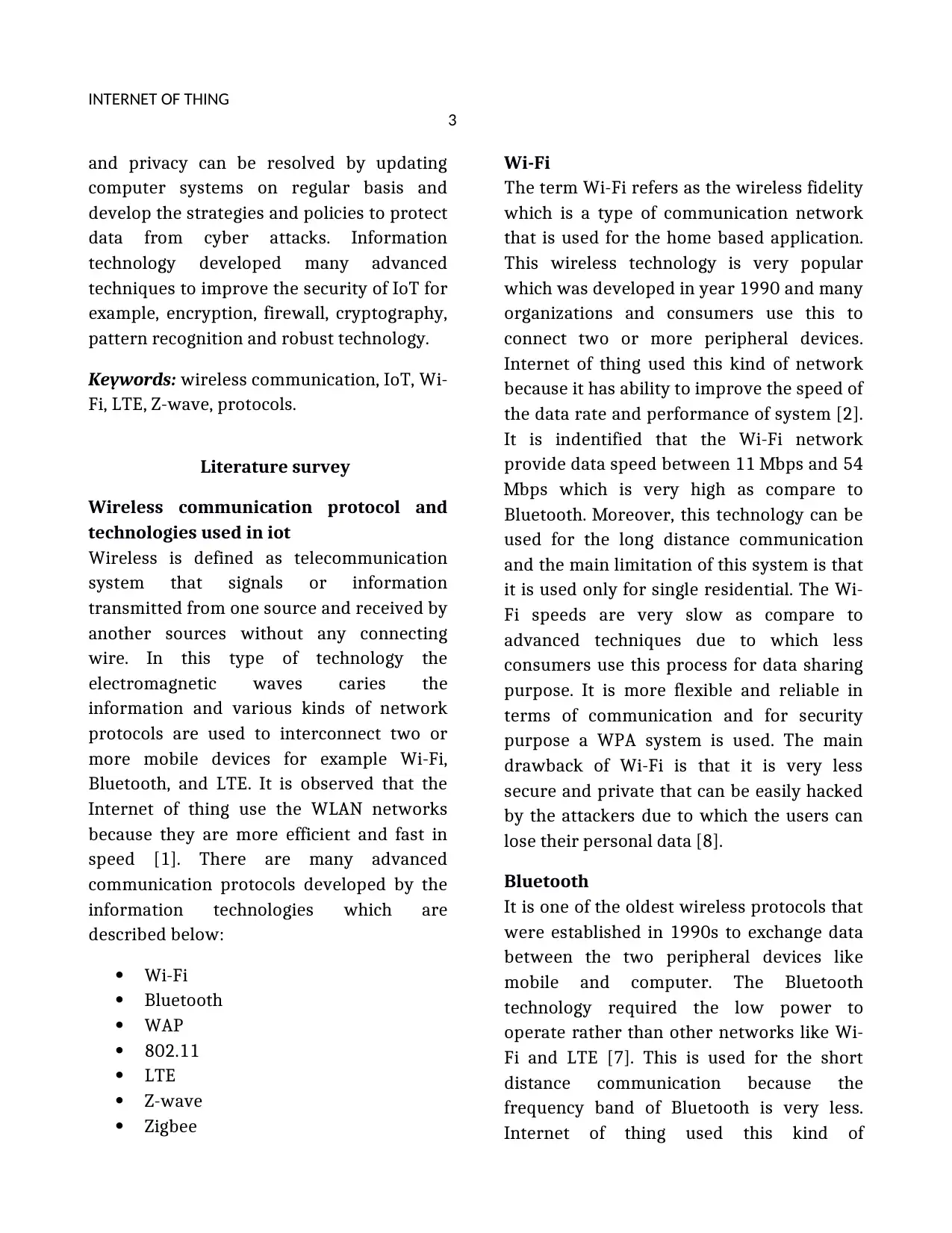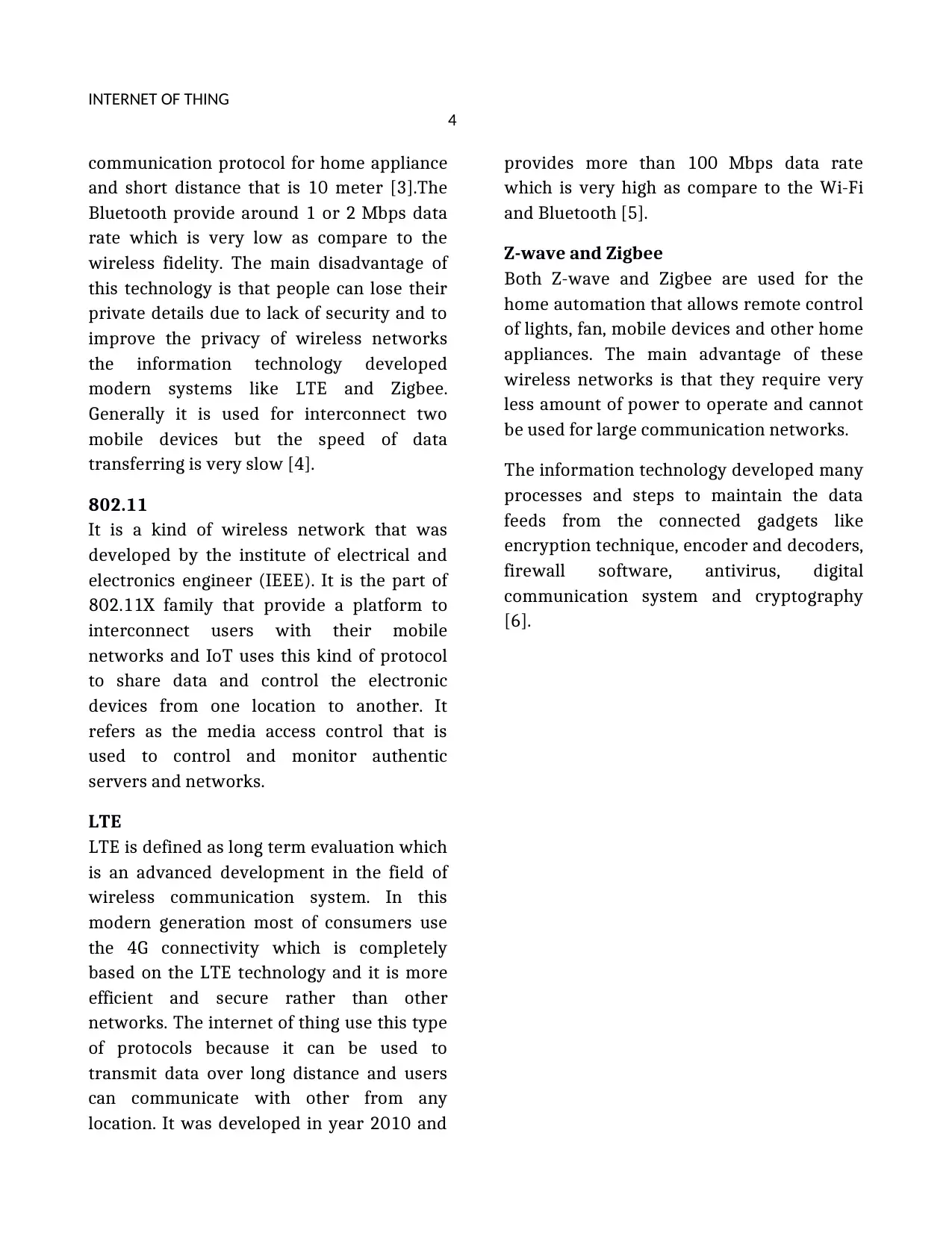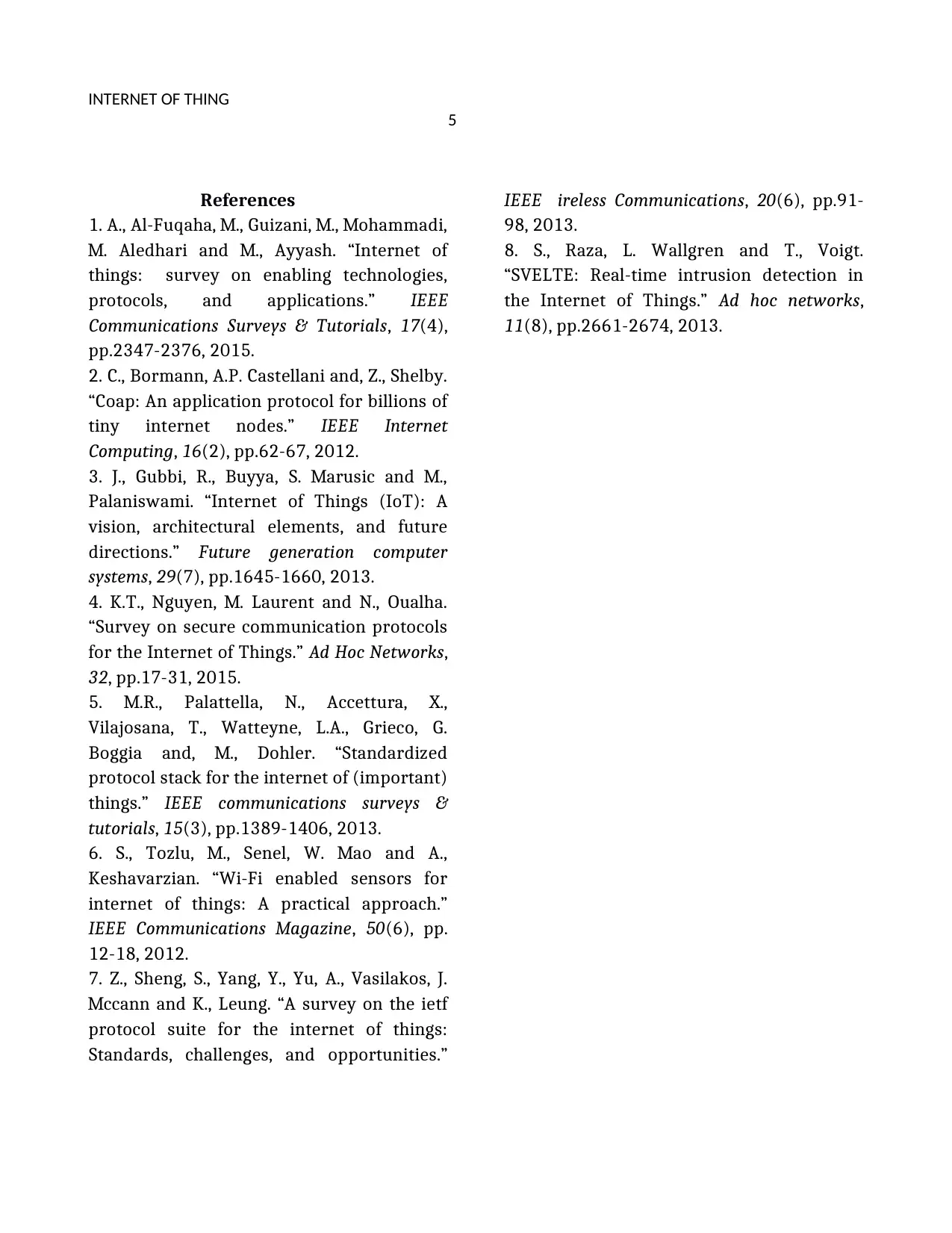Internet of Things (IoT) Wireless Communication Protocols Report
VerifiedAdded on 2023/06/03
|5
|1730
|427
Report
AI Summary
This report provides an overview of the Internet of Things (IoT) and the various wireless communication protocols and technologies utilized within it. It begins by defining IoT and emphasizing its reliance on wireless communication for connecting devices, home appliances, and embedded systems. The report then delves into several key wireless protocols, including Wi-Fi, Bluetooth, LTE, Z-wave, and Zigbee, discussing their advantages and disadvantages. A significant portion of the report addresses the security challenges associated with these protocols, such as data breaches, and suggests solutions like firewalls, encryption, and regular system updates. Furthermore, the report highlights the importance of wireless networks due to their high speed and efficiency, and it concludes by recommending strategies to protect data from cyber threats, such as implementing robust security policies and leveraging advanced IT techniques like cryptography and pattern recognition. The report aims to enhance the reader's understanding of IoT and enable them to compare different wireless protocols effectively.

INTERNET OF THING
1
Internet of thing
1
Internet of thing
Paraphrase This Document
Need a fresh take? Get an instant paraphrase of this document with our AI Paraphraser

INTERNET OF THING
2
Wireless and communication systems
Internet of things (IoT)
Abstract- Internet of thing is an advanced
technology that provides communication
system between peripheral device and
users. It is a kind of network system that
interconnects physical devices, home
appliances and embedded with software
and sensors. The main purpose of this
research is to describe the fundamental
concept of internet of thing and discuss
the wireless protocols and technologies
used in the Internet of thing. In this the
internet protocols are connected with the
other computer devices with the help of
internet. The IoT is completed based on
the wireless technology that provide a
platform to communicate with the
network devices and in which the
transmitter and receiver are connected
with the help of internet connectivity.
This report is explaining the working
principle of IoT technology and different
kinds of wireless network protocol used
in this technique. The wireless network is
modern process of the wired system that
does not require any connecting cables
due to which the speed of data transfer is
very high. The Internet of Things refer to
the consistently developing system of
physical items that element an IP address
for web availability, and the
correspondence that happens between
these articles and other Internet-
empowered gadgets and frameworks.
There are many types of wireless
communication protocols and technologies
used in the field of internet of thing such as
Bluetooth, Wi-Fi, Z-wave, Zigbee, LoraWAN,
and LTE. All these will be described in this
report with their advantages and
disadvantages. It is observed that the main
problem faced by these networks protocol is
that lack of security and due to which the
users can lose their personal data or
information. These type of issue can be
resolved if the users adopt the security plans
like firewall, antivirus, encryption and
cryptography techniques. The main
advantage of wireless network is that they
are more efficient and fast in speed which
can be used for the long distance
communication system. There are many
researchers investigated on this topic and
they indentified that most of organizations
and consumers use wireless technology for
the communication purpose but they do not
follow any security programs to avoid the
cyber treats and risks. To interconnect the
two or more computer networks a
communication protocol is used which is
provided by the wireless system and
internet of thing use this technique because
it has capability to enhance the efficiency of
communication channel. With the help of
this report the reader can increase their
knowledge in the field of internet of thing
and they can compare different kinds of
wireless protocols with each other. It is
recommended that the problem of security
2
Wireless and communication systems
Internet of things (IoT)
Abstract- Internet of thing is an advanced
technology that provides communication
system between peripheral device and
users. It is a kind of network system that
interconnects physical devices, home
appliances and embedded with software
and sensors. The main purpose of this
research is to describe the fundamental
concept of internet of thing and discuss
the wireless protocols and technologies
used in the Internet of thing. In this the
internet protocols are connected with the
other computer devices with the help of
internet. The IoT is completed based on
the wireless technology that provide a
platform to communicate with the
network devices and in which the
transmitter and receiver are connected
with the help of internet connectivity.
This report is explaining the working
principle of IoT technology and different
kinds of wireless network protocol used
in this technique. The wireless network is
modern process of the wired system that
does not require any connecting cables
due to which the speed of data transfer is
very high. The Internet of Things refer to
the consistently developing system of
physical items that element an IP address
for web availability, and the
correspondence that happens between
these articles and other Internet-
empowered gadgets and frameworks.
There are many types of wireless
communication protocols and technologies
used in the field of internet of thing such as
Bluetooth, Wi-Fi, Z-wave, Zigbee, LoraWAN,
and LTE. All these will be described in this
report with their advantages and
disadvantages. It is observed that the main
problem faced by these networks protocol is
that lack of security and due to which the
users can lose their personal data or
information. These type of issue can be
resolved if the users adopt the security plans
like firewall, antivirus, encryption and
cryptography techniques. The main
advantage of wireless network is that they
are more efficient and fast in speed which
can be used for the long distance
communication system. There are many
researchers investigated on this topic and
they indentified that most of organizations
and consumers use wireless technology for
the communication purpose but they do not
follow any security programs to avoid the
cyber treats and risks. To interconnect the
two or more computer networks a
communication protocol is used which is
provided by the wireless system and
internet of thing use this technique because
it has capability to enhance the efficiency of
communication channel. With the help of
this report the reader can increase their
knowledge in the field of internet of thing
and they can compare different kinds of
wireless protocols with each other. It is
recommended that the problem of security

INTERNET OF THING
3
and privacy can be resolved by updating
computer systems on regular basis and
develop the strategies and policies to protect
data from cyber attacks. Information
technology developed many advanced
techniques to improve the security of IoT for
example, encryption, firewall, cryptography,
pattern recognition and robust technology.
Keywords: wireless communication, IoT, Wi-
Fi, LTE, Z-wave, protocols.
Literature survey
Wireless communication protocol and
technologies used in iot
Wireless is defined as telecommunication
system that signals or information
transmitted from one source and received by
another sources without any connecting
wire. In this type of technology the
electromagnetic waves caries the
information and various kinds of network
protocols are used to interconnect two or
more mobile devices for example Wi-Fi,
Bluetooth, and LTE. It is observed that the
Internet of thing use the WLAN networks
because they are more efficient and fast in
speed [1]. There are many advanced
communication protocols developed by the
information technologies which are
described below:
Wi-Fi
Bluetooth
WAP
802.11
LTE
Z-wave
Zigbee
Wi-Fi
The term Wi-Fi refers as the wireless fidelity
which is a type of communication network
that is used for the home based application.
This wireless technology is very popular
which was developed in year 1990 and many
organizations and consumers use this to
connect two or more peripheral devices.
Internet of thing used this kind of network
because it has ability to improve the speed of
the data rate and performance of system [2].
It is indentified that the Wi-Fi network
provide data speed between 11 Mbps and 54
Mbps which is very high as compare to
Bluetooth. Moreover, this technology can be
used for the long distance communication
and the main limitation of this system is that
it is used only for single residential. The Wi-
Fi speeds are very slow as compare to
advanced techniques due to which less
consumers use this process for data sharing
purpose. It is more flexible and reliable in
terms of communication and for security
purpose a WPA system is used. The main
drawback of Wi-Fi is that it is very less
secure and private that can be easily hacked
by the attackers due to which the users can
lose their personal data [8].
Bluetooth
It is one of the oldest wireless protocols that
were established in 1990s to exchange data
between the two peripheral devices like
mobile and computer. The Bluetooth
technology required the low power to
operate rather than other networks like Wi-
Fi and LTE [7]. This is used for the short
distance communication because the
frequency band of Bluetooth is very less.
Internet of thing used this kind of
3
and privacy can be resolved by updating
computer systems on regular basis and
develop the strategies and policies to protect
data from cyber attacks. Information
technology developed many advanced
techniques to improve the security of IoT for
example, encryption, firewall, cryptography,
pattern recognition and robust technology.
Keywords: wireless communication, IoT, Wi-
Fi, LTE, Z-wave, protocols.
Literature survey
Wireless communication protocol and
technologies used in iot
Wireless is defined as telecommunication
system that signals or information
transmitted from one source and received by
another sources without any connecting
wire. In this type of technology the
electromagnetic waves caries the
information and various kinds of network
protocols are used to interconnect two or
more mobile devices for example Wi-Fi,
Bluetooth, and LTE. It is observed that the
Internet of thing use the WLAN networks
because they are more efficient and fast in
speed [1]. There are many advanced
communication protocols developed by the
information technologies which are
described below:
Wi-Fi
Bluetooth
WAP
802.11
LTE
Z-wave
Zigbee
Wi-Fi
The term Wi-Fi refers as the wireless fidelity
which is a type of communication network
that is used for the home based application.
This wireless technology is very popular
which was developed in year 1990 and many
organizations and consumers use this to
connect two or more peripheral devices.
Internet of thing used this kind of network
because it has ability to improve the speed of
the data rate and performance of system [2].
It is indentified that the Wi-Fi network
provide data speed between 11 Mbps and 54
Mbps which is very high as compare to
Bluetooth. Moreover, this technology can be
used for the long distance communication
and the main limitation of this system is that
it is used only for single residential. The Wi-
Fi speeds are very slow as compare to
advanced techniques due to which less
consumers use this process for data sharing
purpose. It is more flexible and reliable in
terms of communication and for security
purpose a WPA system is used. The main
drawback of Wi-Fi is that it is very less
secure and private that can be easily hacked
by the attackers due to which the users can
lose their personal data [8].
Bluetooth
It is one of the oldest wireless protocols that
were established in 1990s to exchange data
between the two peripheral devices like
mobile and computer. The Bluetooth
technology required the low power to
operate rather than other networks like Wi-
Fi and LTE [7]. This is used for the short
distance communication because the
frequency band of Bluetooth is very less.
Internet of thing used this kind of
⊘ This is a preview!⊘
Do you want full access?
Subscribe today to unlock all pages.

Trusted by 1+ million students worldwide

INTERNET OF THING
4
communication protocol for home appliance
and short distance that is 10 meter [3].The
Bluetooth provide around 1 or 2 Mbps data
rate which is very low as compare to the
wireless fidelity. The main disadvantage of
this technology is that people can lose their
private details due to lack of security and to
improve the privacy of wireless networks
the information technology developed
modern systems like LTE and Zigbee.
Generally it is used for interconnect two
mobile devices but the speed of data
transferring is very slow [4].
802.11
It is a kind of wireless network that was
developed by the institute of electrical and
electronics engineer (IEEE). It is the part of
802.11X family that provide a platform to
interconnect users with their mobile
networks and IoT uses this kind of protocol
to share data and control the electronic
devices from one location to another. It
refers as the media access control that is
used to control and monitor authentic
servers and networks.
LTE
LTE is defined as long term evaluation which
is an advanced development in the field of
wireless communication system. In this
modern generation most of consumers use
the 4G connectivity which is completely
based on the LTE technology and it is more
efficient and secure rather than other
networks. The internet of thing use this type
of protocols because it can be used to
transmit data over long distance and users
can communicate with other from any
location. It was developed in year 2010 and
provides more than 100 Mbps data rate
which is very high as compare to the Wi-Fi
and Bluetooth [5].
Z-wave and Zigbee
Both Z-wave and Zigbee are used for the
home automation that allows remote control
of lights, fan, mobile devices and other home
appliances. The main advantage of these
wireless networks is that they require very
less amount of power to operate and cannot
be used for large communication networks.
The information technology developed many
processes and steps to maintain the data
feeds from the connected gadgets like
encryption technique, encoder and decoders,
firewall software, antivirus, digital
communication system and cryptography
[6].
4
communication protocol for home appliance
and short distance that is 10 meter [3].The
Bluetooth provide around 1 or 2 Mbps data
rate which is very low as compare to the
wireless fidelity. The main disadvantage of
this technology is that people can lose their
private details due to lack of security and to
improve the privacy of wireless networks
the information technology developed
modern systems like LTE and Zigbee.
Generally it is used for interconnect two
mobile devices but the speed of data
transferring is very slow [4].
802.11
It is a kind of wireless network that was
developed by the institute of electrical and
electronics engineer (IEEE). It is the part of
802.11X family that provide a platform to
interconnect users with their mobile
networks and IoT uses this kind of protocol
to share data and control the electronic
devices from one location to another. It
refers as the media access control that is
used to control and monitor authentic
servers and networks.
LTE
LTE is defined as long term evaluation which
is an advanced development in the field of
wireless communication system. In this
modern generation most of consumers use
the 4G connectivity which is completely
based on the LTE technology and it is more
efficient and secure rather than other
networks. The internet of thing use this type
of protocols because it can be used to
transmit data over long distance and users
can communicate with other from any
location. It was developed in year 2010 and
provides more than 100 Mbps data rate
which is very high as compare to the Wi-Fi
and Bluetooth [5].
Z-wave and Zigbee
Both Z-wave and Zigbee are used for the
home automation that allows remote control
of lights, fan, mobile devices and other home
appliances. The main advantage of these
wireless networks is that they require very
less amount of power to operate and cannot
be used for large communication networks.
The information technology developed many
processes and steps to maintain the data
feeds from the connected gadgets like
encryption technique, encoder and decoders,
firewall software, antivirus, digital
communication system and cryptography
[6].
Paraphrase This Document
Need a fresh take? Get an instant paraphrase of this document with our AI Paraphraser

INTERNET OF THING
5
References
1. A., Al-Fuqaha, M., Guizani, M., Mohammadi,
M. Aledhari and M., Ayyash. “Internet of
things: survey on enabling technologies,
protocols, and applications.” IEEE
Communications Surveys & Tutorials, 17(4),
pp.2347-2376, 2015.
2. C., Bormann, A.P. Castellani and, Z., Shelby.
“Coap: An application protocol for billions of
tiny internet nodes.” IEEE Internet
Computing, 16(2), pp.62-67, 2012.
3. J., Gubbi, R., Buyya, S. Marusic and M.,
Palaniswami. “Internet of Things (IoT): A
vision, architectural elements, and future
directions.” Future generation computer
systems, 29(7), pp.1645-1660, 2013.
4. K.T., Nguyen, M. Laurent and N., Oualha.
“Survey on secure communication protocols
for the Internet of Things.” Ad Hoc Networks,
32, pp.17-31, 2015.
5. M.R., Palattella, N., Accettura, X.,
Vilajosana, T., Watteyne, L.A., Grieco, G.
Boggia and, M., Dohler. “Standardized
protocol stack for the internet of (important)
things.” IEEE communications surveys &
tutorials, 15(3), pp.1389-1406, 2013.
6. S., Tozlu, M., Senel, W. Mao and A.,
Keshavarzian. “Wi-Fi enabled sensors for
internet of things: A practical approach.”
IEEE Communications Magazine, 50(6), pp.
12-18, 2012.
7. Z., Sheng, S., Yang, Y., Yu, A., Vasilakos, J.
Mccann and K., Leung. “A survey on the ietf
protocol suite for the internet of things:
Standards, challenges, and opportunities.”
IEEE ireless Communications, 20(6), pp.91-
98, 2013.
8. S., Raza, L. Wallgren and T., Voigt.
“SVELTE: Real-time intrusion detection in
the Internet of Things.” Ad hoc networks,
11(8), pp.2661-2674, 2013.
5
References
1. A., Al-Fuqaha, M., Guizani, M., Mohammadi,
M. Aledhari and M., Ayyash. “Internet of
things: survey on enabling technologies,
protocols, and applications.” IEEE
Communications Surveys & Tutorials, 17(4),
pp.2347-2376, 2015.
2. C., Bormann, A.P. Castellani and, Z., Shelby.
“Coap: An application protocol for billions of
tiny internet nodes.” IEEE Internet
Computing, 16(2), pp.62-67, 2012.
3. J., Gubbi, R., Buyya, S. Marusic and M.,
Palaniswami. “Internet of Things (IoT): A
vision, architectural elements, and future
directions.” Future generation computer
systems, 29(7), pp.1645-1660, 2013.
4. K.T., Nguyen, M. Laurent and N., Oualha.
“Survey on secure communication protocols
for the Internet of Things.” Ad Hoc Networks,
32, pp.17-31, 2015.
5. M.R., Palattella, N., Accettura, X.,
Vilajosana, T., Watteyne, L.A., Grieco, G.
Boggia and, M., Dohler. “Standardized
protocol stack for the internet of (important)
things.” IEEE communications surveys &
tutorials, 15(3), pp.1389-1406, 2013.
6. S., Tozlu, M., Senel, W. Mao and A.,
Keshavarzian. “Wi-Fi enabled sensors for
internet of things: A practical approach.”
IEEE Communications Magazine, 50(6), pp.
12-18, 2012.
7. Z., Sheng, S., Yang, Y., Yu, A., Vasilakos, J.
Mccann and K., Leung. “A survey on the ietf
protocol suite for the internet of things:
Standards, challenges, and opportunities.”
IEEE ireless Communications, 20(6), pp.91-
98, 2013.
8. S., Raza, L. Wallgren and T., Voigt.
“SVELTE: Real-time intrusion detection in
the Internet of Things.” Ad hoc networks,
11(8), pp.2661-2674, 2013.
1 out of 5
Related Documents
Your All-in-One AI-Powered Toolkit for Academic Success.
+13062052269
info@desklib.com
Available 24*7 on WhatsApp / Email
![[object Object]](/_next/static/media/star-bottom.7253800d.svg)
Unlock your academic potential
Copyright © 2020–2025 A2Z Services. All Rights Reserved. Developed and managed by ZUCOL.





